SPOT 2013: a bold new ’residential gallery’ curated by Nina Yashar, Daniele Balice & Giò Marconi
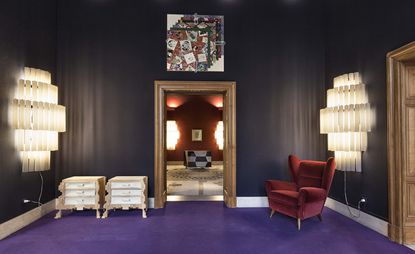
Fiac, the annual international art fair in Paris, doesn't officially get underway until Thursday. But already, SPOT 2013 has managed to distinguish itself as an exciting nexus of design and art.
A collaboration between design powerhouse Nina Yashar of Milan's Nilufar Gallery, Paris-based art influencer Daniele Balice of the Balice Hertling Gallery and Giò Marconi (also from Milan), the project occupies a 1,500 sq m hôtel particulier that was formerly a museum dedicated to the city's hospitals.
It only takes a glimpse of Shigeru Ban's cardboard Paper Tea House – a piece Yashar has never before exhibited – to realise that her showcase of rare design art in a residential setting blurs all sorts of curatorial and commercial lines.
Part of the challenge at art fairs or even just in galleries is that you can never visualise how something will look outside the white-walled vacuum. The three minds behind SPOT aren't simply staging their work in an environment in order to encourage sales; they are encouraging visitors to consider a new eclecticism.
'It's a pop-up but the real reason to show pieces in a place like this is to give context to the pieces,' explains Yashar, who oversaw a much smaller version, SQUAT, last year. 'And to make people have dreams that they could see a space like this exist.'
In a sense, SPOT represents a self-contained microcosm within the Fiac hustle and bustle. Its strength is that the three minds appear fully in sync, drawing from their own collections, requesting loans, commissioning unique works (Patricia Urquiola constructed a geometric 'boiserie' in a high gloss material called Alicrite) and calling in some very special favours (Yashar's pal, Miuccia Prada offered a few bolts of printed fabric that hang as draped panels throughout the space).
The team has sparked conversations between their collections. In a violet room conceived for relaxation, the grid framework of a bookshelf by Ignazio Gardella speaks the same language as a site-specific light installation of intersecting brass bars by Isabelle Stanislas. To this, Balice has added works by artist Alexander May who deconstructs words into graphic patterns.
Yashar named a large space on the upper floor the 'Gamper Ponti' room because it combines London-based Martino Gamper's appropriated salvaged Ponti furniture from the Parco dei Principe hotel in Sorrento with Ponti originals – and all of them have been positioned around Gamper's carpet depicting the floor plan of a 30 sq m apartment. Gino Sarfatti lamps and assorted pieces from Gio Ponti's prime period punctuate several rooms. 'She's not trying to show design as if it's in an art gallery, which is what you see often today,' says Balice. 'The pieces here all feel respected.'
Still, Yashar insists she doesn't belabour her decisions. 'I am not able to overthink,' she says. 'It makes me confused.' The irony, of course, is that the entire project could have ended up confused - the BBPR-designed enormous drum lights from the 1950s, the Japanese Edo period screens and the Pietro Chiesa cabinet with glass drawers have nothing in common. And yet staggered throughout the space, every item belongs.
Arguably the most inspired new works to emerge from this massive project are the eight tables designed by Giancarlo Montebello. Underneath their glass tops are high-resolution scans from artist Isabelle Cornaro that show clusters of chains, ribbons and other miscellaneous gewgaws all organised neatly.
Asked why she returned to Paris to mount this enormous undertaking, she quipped, 'I feel like a queen in Paris!' Then, more seriously, she added, 'People are very open to the [design] profession here and I appreciate that.' In a perfect world, she says someone would come in and buy everything in one fell swoop.
But for the time being, SPOT serves as an inspirational folly for all to see – that is, when it is not playing backdrop for various private events. Which pleases Balice just fine. 'We want to keep it alive, not just leave it as a showroom,' he says. 'It already feels very cozy, so we have to use it.'
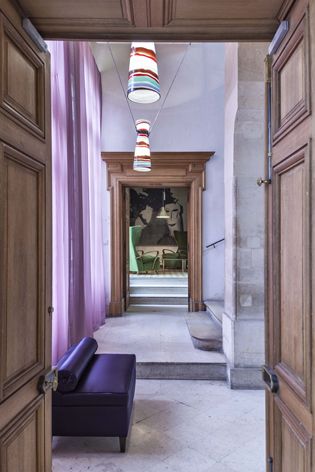
The connecting 'Le Grand Escalier' corridor features an Nilufar Editions Ninetta chaise with a pair of Bergere armchairs and a David Noonan artwork hung in the distance
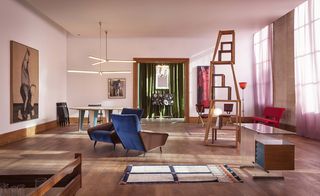
Within the 'Stanza Le Salon du Plaisir', the left-hand wall features an artwork by David Noonan. In the foreground: a blue Distex armchair by Gio Ponti, 19th century Tibetan carpet, Montefeltro bookcase by Michele de Lucchi, desk by Gio Ponti and, just behind, a Vietnam bench from Nilufar Gallery
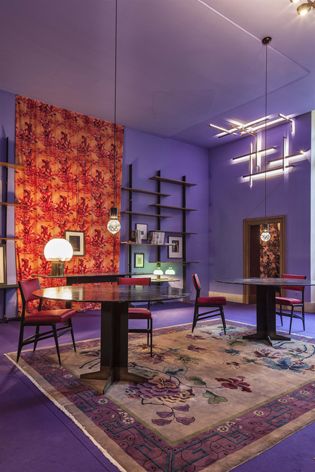
Within the purple hued 'Stanza Fiat Lux', a pair of round tables by Ignazio Gardella are accompanied by Gio Ponti chairs and a bookcase by Ignazio Gardella. Hanging above are two bulb lights by Seguso and on the right wall is a graphic light installation by Isabelle Stanislas
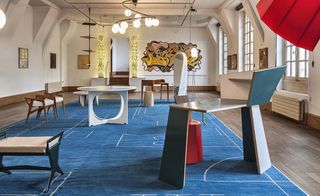
In the main 'Stanza Amengement' gallery, a bench by Ico Parisi sits in the foreground. Behind are two stools by Gio Ponti, a central Apta Series table by Gio Ponti, an angular desk by Martino Gamper and an accompanying Arnold Circus stool also by Gamper. On the floor: House Plan Carpet by Martino Gamper. Hanging from the ceiling: Lamp by Studio BBPR and suspending bookshelf by Martino Gamper

Finally, the 'La Torretta' sitting room is furnished with a ceiling lamp by Archimede Seguso, artwork by Markus Schinwald, and a sofa and armchair by Carl Malmsten. Underfoot: a 1940 French carpet. Miuccia Prada - a pal of Nilufar Gallery's Nina Yashar (who co-curated SPOT) - offered a few bolts of printed fabric to the project, which hang as draped panels throughout the space
ADDRESS
Hôtel de Miramion, 47 Quai de la Tournelle, 75005 Paris
Wallpaper* Newsletter
Receive our daily digest of inspiration, escapism and design stories from around the world direct to your inbox
-
 Enjoy ocean and jungle bliss at Bespoke Tulum’s residences in Mexico
Enjoy ocean and jungle bliss at Bespoke Tulum’s residences in MexicoBespoke Tulum is an exclusive hospitality complex designed by Muro Rojo Arquitectura on Mexico’s Caribbean coastline
By Sofia de la Cruz Published
-
 In Van Cleef & Arpels’ high jewellery, the archival meets the au courant
In Van Cleef & Arpels’ high jewellery, the archival meets the au courantVan Cleef & Arpels pays tribute to its rich heritage with a captivating high jewellery collection
By Hannah Silver Published
-
 New Nothing Ear and Ear (a) earbuds: audio innovation with a retro nod
New Nothing Ear and Ear (a) earbuds: audio innovation with a retro nodNothing’s new Ear and Ear (a) earbuds, drawing inspiration from vintage portable hi-fi and packed with updates, help the company maintain its status as an audio innovator
By Jonathan Bell Published
-
 The Nilufar Depot: function and style meet in Milan’s new treasure trove
The Nilufar Depot: function and style meet in Milan’s new treasure troveBy JJ Martin Last updated
-
 ’Squat #1’ by Nilufar Gallery, Dimore Studio and Balice Hertling, Paris
’Squat #1’ by Nilufar Gallery, Dimore Studio and Balice Hertling, ParisBy Ellen Himelfarb Last updated